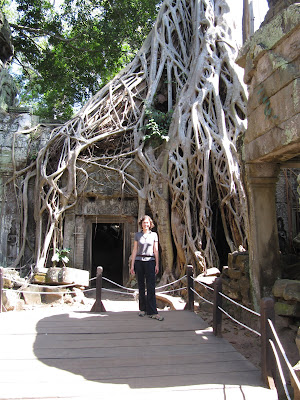














December 3, 2010
There's a reason why Angkor Wat was declared a UNESCO World Heritage site in 1992. It's outrageously beautiful, serene, and reeks of spirituality. You may practice voodoo, but you'll still be moved by the Hindu and Buddhist shrines here. And, the word's out because most everyone of all stripes of religions come visit and after Tomb Raider was shot here, even more tourists come.
They started building these temples back in AD 1002 and had active cities filled with huge and numerous temples. Almost a million people were said to live in one city, at a time when London only had 50,000 people. Each king from AD 1000 on created more and more Buddhist or Hindua temples, or temples dedicated to a mix of Hindu and Buddhism. Over time, Hindu religion has been synthesized with Buddhism here in Cambodia. Cambodians may say most of them are Buddhist, but they've actually borrowed a lot from Hindus too. One king couldn't handle combining shrines and statues from both religions, so he just chopped off the over 200 Buddhist heads that created beautiful ornamentation around one shrine. Or, he'd add a beard and change the meditation position of the Buddha to make him look more Hindu (see decapitated statue and bearded Buddha converted to Hinduism above). But, there are still a lot of Buddhas remaining. Almost 215 in one temple you can see above, with 4 Buddha faces on the head that tops each of over 50 towers at one temple.
My Buddhist practice is expanding while living here in Asia. And, I found walking around Angkor Wat temples like meditative prayer, slowing down every moment to where I feel incredibly present and alive. A guide named Bond, who's a Cambodian who's incredibly well-read in Hindu and Buddhist mythology, took me to the most hidden temples, where you have to hike through jungles. He also took me to the most overcrowded temples at the least crowded times of day.
Meditative peace is the only way I can describe the feeling of going to the first temple, Ta Nei, hidden deep in the jungle (see first pictures above). And, NO ONE was there. It's hard to imagine that at Angkor Wat. It's like being able to see the Statue of Liberty on a day when no one shows up. You feel like the statue is yours. And, that temple was mine, for the moment. My temple was broken down and rubble-filled but it had all these huge blocks for me to climb over before I could get into the narrow corridors, former libraries, statues, and shrines from the 2nd century. All the buildings were covered by celestial dancers named Apsara who would bring heaven to earth, especially when they acted as concubines to the King.
Ta Keo shrine took me up a huge number of temple steps to an outrageous view. Then, Ta Prom temple (known as the Tomb Raider temple to most tourists here since the film was shot in it) is covered in huge trees named Spung with roots draped over the side of the temple (see pics above of me next to roots).
The great city of Angkor Thom was the largest city in the world by the end of the 12th century, with almost a million people. It is surrounded by a wall that has a victory and a death entrance. The Khmer army of the time would return from battle either via the victory or death entrances, depending on the outcome of their battles. And, 3 headed elephants (see 3 trunks holding up the archway of the wall entrance above) were at each entrance, said to hold up heaven above the city, keeping God close by.
Angkor Thom was the largest city in the world, until the Thai army raided it in the 12th century. The army couldn't break into the walled city, given its moat and huge walls, but it waited patiently beside the city for one and a half years until they starved the citydwellers into submission. The Thai army then took most of the millions of pearls, diamonds, and gold that adorned the sparkling interior tower that lit up with bejeweled light once a day when the sun would hit the top of the tower just right, leading to a transcendent, sparkling Buddha at the tower base. Nine centuries later, my guide is still bitter towards the Thai, as a result of that and a laundry list of other even more recent Thai invasions.
But, before the Thai took over for a short time, Angkor Thom was a thriving city filled with the 217 Buddha faces I described above, and still, today it has practicing Buddhist monks who keep Buddhist shrines alive there. I was ambivalent about meditating at the Angkor Thom Buddhist shrine. But, I forced myself to do it, despite the watchful eyes of those who collected the money from me for the incense. It was probably the most spiritual place I've ever meditated but it was also the shortest and most uncomfortable prayer for me, with all the locals and the monks watching, with some locals tittering and staring.
At the end of that first day, my guide gave me a gin and tonic to watch the sun set by the side of the Angkor Wat moat that we planned to cross the next day to see the temple of all temples - the official Angkor Wat temple.
Wow, Been, what a wonderful experience!!!!
ReplyDelete